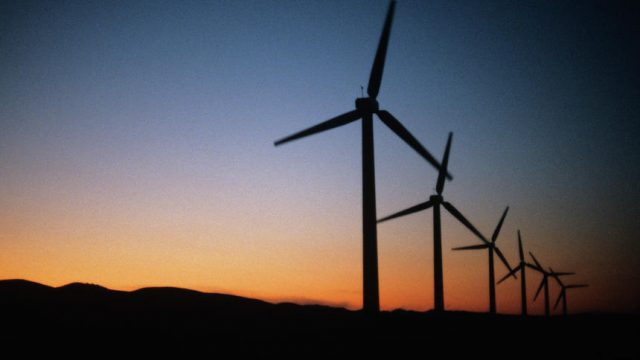Connie Krapp: Before Permitting Another Wind Mill North Dakota’s PSC Must Publicize Costs for Taxpayers and Energy Consumers

Wind turbines generating electricity
News broke this week that a 130,000-acre wind farm originally proposed six years ago near Merricourt in south-central North Dakota is back on the burner. Last month, Otter Tail Power Company paid the $175,000 filing fee to get the project back in front of the North Dakota Public Service Commission. In so doing, it resurrected the western Dickey County project (which will have a footprint of 20 square miles) that it once killed when it cancelled its power purchase agreement with wind farm developer EDF Renewable Energy. Since the PSC has vetted this project before, one could assume the project will get a quick green light and be built according to schedule.
But not so fast. Information on the cost of the project was redacted from the public copies of documents filed by OTPC. Why? Isn’t it the right of the public to know the cost of the project? And more importantly, don’t we have the right to know how much of that cost will be picked up by us as taxpayers and consumers? Why should ANY wind farm be built until we all understand what it will cost us?
Enter the Production Tax Credit. The federal government is spending wildly to subsidize wind. Did you know that, from 2010 to 2013, the federal government paid 52 times as much for a unit of wind energy as it spent on a unit of energy produced from fossil fuels? Read all about it here.
[mks_pullquote align=”right” width=”300″ size=”24″ bg_color=”#ffffff” txt_color=”#000000″]The federal government is spending wildly to subsidize wind. Did you know that, from 2010 to 2013, the federal government paid 52 times as much for a unit of wind energy as it spent on a unit of energy produced from fossil fuels?[/mks_pullquote]
While US Production Tax Credits are scheduled to be phased out by 2019, there is a chance that Congress will extend them again as it has done repeatedly in the past. But the PTC isn’t the only windfall. A U.S. Government Accountability Office (GAO) report counted 82 different programs spread across nine agencies that provided tax breaks, loan guarantees, or other economic assistance to the wind industry.
At the same time, many state and local governments also provide support for wind power through programs ranging from renewable power purchase mandates to local property tax breaks. What is the cost of all of that to taxpayers—federal, state and local?
And speaking of costs—how does the TRUE cost of wind energy impact our electricity bills? A 2015 study by the Institute for Energy Research shows that on average, electricity from new wind resources is nearly three times more expensive than from existing coal.
Despite the fact that in this state, the wind seems to blow all the time, our experience here confirms it: wind turbines produce energy about 40 percent of the time—and must be backed up by “firm” generation sources such as gas or coal. Keeping that baseload generation online for times when wind turbines are offline blows electricity costs skyward. OTPC already charges a 7-percent “Renewable Resource Adjustment” on my electric bill to cover the cost of renewable generation. Other utilities charge similarly—or bury the extra cost of renewables by raising rates across the board.
Yet, there is plenty of literature out there that insists that wind energy costs the same—or even less than— energy produced from gas or coal. These claims omit the millions of dollars swept into wind projects courtesy of the US taxpayer. It seems as though the wind industry is also adept at communicating the riches and taxes paid to landowners, communities and regions from wind farms. Where is the data that indicates how much in taxes and added electricity costs we taxpayers already pay for wind? Where is honest data that documents the impact wind energy has on reducing carbon emissions?
No, we don’t need bogus statements that say the cost of wind energy is comparable to the cost of energy from other sources. We need the facts—a complete cost/benefit analysis of wind generation. Please contact the Public Service Commission at ndpsc@nd.gov requesting it presents the true cost of wind energy – and its effect on carbon emissions— to consumers and taxpayers next time—and every time— it has a public hearing on a wind farm.
Note: I have no dog in this fight—I don’t work in the energy industry (but did work for an electric utility for 22 years and hence, my interest). I own land far from any wind farm (thankfully), and do not have neighbors or anybody else profiting or hoping to profit on wind. My interest is solely from the perspective of a taxpayer and consumer who has found, after careful research, that wind energy does not significantly reduce carbon emissions. It has dramatically driven up the cost of electricity in other countries and states, and has already resulted in higher electric bills for North Dakotans. All of this and yet, there has never been an honest and open cost/benefit analysis of wind generation in North Dakota!
But most compelling to me is our reality that once these monstrous wind turbines go up, we have to live with them for at least 20 years. It’s imperative that we approach the addition of wind generation in North Dakota and elsewhere with fiscal responsibility and an eye on technology and innovation that will one day make wind farms a relic of an unfortunate past.




